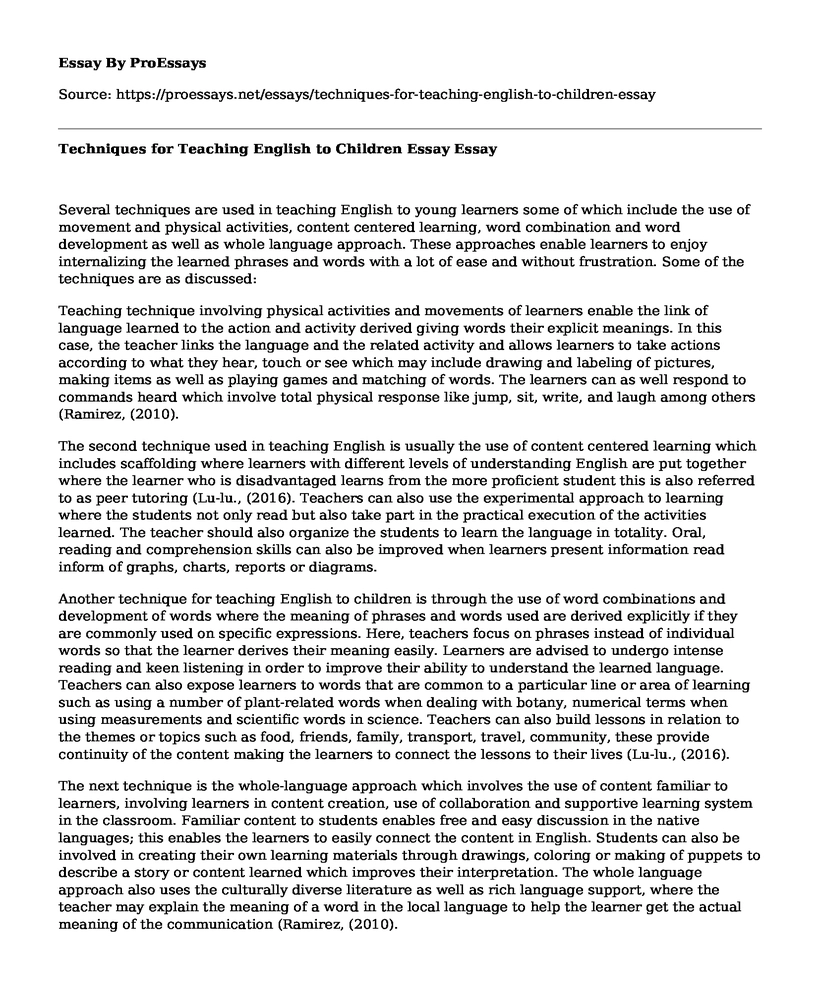Several techniques are used in teaching English to young learners some of which include the use of movement and physical activities, content centered learning, word combination and word development as well as whole language approach. These approaches enable learners to enjoy internalizing the learned phrases and words with a lot of ease and without frustration. Some of the techniques are as discussed:
Teaching technique involving physical activities and movements of learners enable the link of language learned to the action and activity derived giving words their explicit meanings. In this case, the teacher links the language and the related activity and allows learners to take actions according to what they hear, touch or see which may include drawing and labeling of pictures, making items as well as playing games and matching of words. The learners can as well respond to commands heard which involve total physical response like jump, sit, write, and laugh among others (Ramirez, (2010).
The second technique used in teaching English is usually the use of content centered learning which includes scaffolding where learners with different levels of understanding English are put together where the learner who is disadvantaged learns from the more proficient student this is also referred to as peer tutoring (Lu-lu., (2016). Teachers can also use the experimental approach to learning where the students not only read but also take part in the practical execution of the activities learned. The teacher should also organize the students to learn the language in totality. Oral, reading and comprehension skills can also be improved when learners present information read inform of graphs, charts, reports or diagrams.
Another technique for teaching English to children is through the use of word combinations and development of words where the meaning of phrases and words used are derived explicitly if they are commonly used on specific expressions. Here, teachers focus on phrases instead of individual words so that the learner derives their meaning easily. Learners are advised to undergo intense reading and keen listening in order to improve their ability to understand the learned language. Teachers can also expose learners to words that are common to a particular line or area of learning such as using a number of plant-related words when dealing with botany, numerical terms when using measurements and scientific words in science. Teachers can also build lessons in relation to the themes or topics such as food, friends, family, transport, travel, community, these provide continuity of the content making the learners to connect the lessons to their lives (Lu-lu., (2016).
The next technique is the whole-language approach which involves the use of content familiar to learners, involving learners in content creation, use of collaboration and supportive learning system in the classroom. Familiar content to students enables free and easy discussion in the native languages; this enables the learners to easily connect the content in English. Students can also be involved in creating their own learning materials through drawings, coloring or making of puppets to describe a story or content learned which improves their interpretation. The whole language approach also uses the culturally diverse literature as well as rich language support, where the teacher may explain the meaning of a word in the local language to help the learner get the actual meaning of the communication (Ramirez, (2010).
Conclusion
In conclusion, the teacher should prepare the learner for the particular techniques or a combination of techniques used in order to participate in a conducive environment that enables retention of the learned concepts. The techniques enable the learners to master the learned words by using a simple procedure which is enjoyable and with no frustrations.
References
Ramirez, S. (2010). How shall we teach English to non-English-speaking children. Lewiston, N.Y.: Edwin Mellen Press.
REN Lu-lu. (2016). A Study of Application of Games in Children English Teaching-Taking Children English Class in Education First Training School for Example. Sino-US English Teaching, 13(9). doi: 10.17265/1539-8072/2016.09.004
Cite this page
Techniques for Teaching English to Children Essay. (2022, Aug 04). Retrieved from https://proessays.net/essays/techniques-for-teaching-english-to-children-essay
If you are the original author of this essay and no longer wish to have it published on the ProEssays website, please click below to request its removal:
- Differing Perspective on Learning Essay
- Best Approaches for Fixing the Problem of Insecurity in American Schools
- Essay Sample on Writing Portfolio
- Children Policy on Ohio For Immigrants - Essay Sample
- School Principal: Leader, Link & Policy Enforcer - Essay Sample
- Paper Example on Tech in Schools - Enhancing Education in Dubai
- Dual Language Acquisition - Free Essay Example







